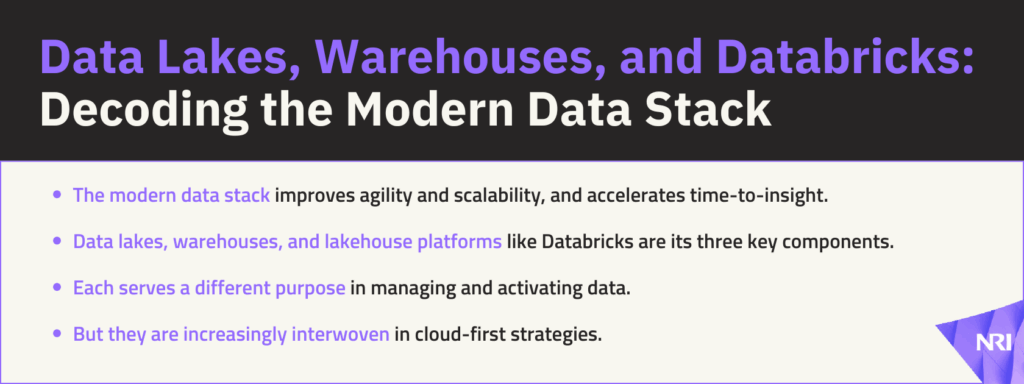Modernize your data architecture for agility, scalability, and faster time-to-insight.

As enterprises seek faster insights and more flexible analytics, the “modern data stack” has become a foundational enabler of digital transformation.
This “modern data stack” is built on a modular architecture, with multiple technologies and customizable components. It includes a cloud platform, a data pipeline, and orchestration tools such as Python or Apache Airflow, for efficient data flow and task execution. Data is typically stored in a lake or warehouse. Analytics engines, such as Tableau, Power BI, and Looker, are utilized to visualize key insights and support data-driven decision-making. And increasingly, lakehouse platforms, such as Databricks, are used to establish a single source of truth for their data and unify analytics.
This article breaks down the differences between data lakes, data warehouses, and unified platforms like Databricks, where they intersect, and how organizations can architect a data stack that supports real-time analytics, machine learning, and scalable business intelligence. Let’s dive in!
Data Lakes vs. Data Warehouses: Core Differences
A data warehouse collects and consolidates structured historical data with predefined schemas to support analytical purposes such as business intelligence.
Popular ones include:
- Amazon Redshift
- Google BigQuery
- Snowflake
Data warehouses were a response to the growing volume of data in the 1990s, when data silos became increasingly problematic. They were made possible through the relational databases and the theories of structuring and normalizing data, advanced by Edgar Codd in the 1970s.
In the 2000s, the growth of unstructured and semi-structured data led to the emergence of big data and the concept of the data lake.
A data lake allows data scientists and engineers to mine and analyze large datasets for various purposes, utilizing tools and techniques such as machine learning.
One of the first data lake frameworks was Hadoop, which provided a distributed file system and processing framework that could handle massive amounts of data, allowing for the creation, storage, and management of data lakes.
The leading data lake vendors today include:
- AWS S3
- Google Cloud
- Microsoft Azure
- Snowflake
Data lakes offer numerous benefits, including flexibility, scalability, cost-effectiveness, and innovation. However, they also present several challenges, including data quality, governance, security, and integration. In some cases, a poorly managed data lake can become a data swamp, which is a term for a data lake that is inaccessible or unreliable.
Where Databricks Fits In
Data lakehouse platforms, such as Databricks, provide a more efficient option to manage structured, semi-structured, and unstructured data. They combine the ease of access and support for analytics of data warehouses with the flexibility and cost advantages of data lakes.
Lakehouses utilize a new system design that implements similar data structures and features to those found in data warehouses, such as transactions, ACID (atomicity, consistency, isolation, and durability) properties, and indexes.
They sit directly on top of low-cost cloud storage through open file formats such as Apache Parquet, Avro, and Delta Lake. And they can support unified analytics, including business intelligence, machine learning, and real-time analytics, across both structured, unstructured, and semi-structured data. Features such as transactions, concurrency control, time travel, audit history, backup, and disaster recovery come built in.
Furthermore, lakehouse platforms like Databricks allow you to monitor and troubleshoot data pipelines and workflows, as well as ensure platform availability and reliability.
Building an Integrated Data Architecture
So, should you use a data lake, a data warehouse, or a hybrid model?
Data lakes can store raw, unstructured data at scale. So, they are ideal for advanced analytics, machine learning, and scenarios where data variety and flexibility are priorities.
On the other hand, data warehouses optimize structured data for fast, reliable querying and business intelligence, making them an excellent option for use cases that require governance and high-performance SQL analytics.
Using a data lakehouse to bring both capabilities under one roof can help boost flexibility and performance. And it can be especially effective when you need to support a variety of data types, or when advanced analytics, real-time insights, and traditional reporting must coexist.
Ultimately, the platform you choose should provide seamless integration with cloud services for ingestion, streaming, and AI. And they should have built-in governance, monitoring, and regulatory controls, and allow you to seamlessly scale resources to match workloads seamlessly.
Managed platforms like Databricks, Azure Synapse, AWS Redshift, and Snowflake offer hands-off scaling, automated maintenance, and built-in security. In contrast, self-managed Hadoop or Spark clusters give you greater control, but at the cost of more DevOps overhead.
Getting It Right: Best Practices for IT Leaders
So how can you create a modern data stack?
Start by assessing business and infrastructure needs. What are your data sources, formats, volume, and user needs? What are the analytics, reporting, AI/ML, and compliance objectives? What bottlenecks exist in current processes and infrastructure?
Once you have a clear understanding of requirements, create a scalable roadmap for data maturity. Start by establishing secure, governed storage in the cloud. Next, automate ingestion, transformation, and cataloging, and add tools for BI, machine learning, and real-time analytics. Finally, iterate as data needs evolve.
If you need support with data strategy, migration, and modernization, consider partnering with NRI.
Our experts can help profile your data landscape, benchmark maturity, and define target operating models aligned with your business goals.
Beyond strategy, we can also handle the technical aspects of implementing your new data architecture. This includes moving on-premises or legacy data assets to the cloud with minimal downtime, as well as re-architecting pipelines and enabling automation to accelerate the transformation.
Additionally, we can help you manage change with comprehensive training for your in-house team. Post-implementation, we can continuously optimize the data architecture to control costs, enforce governance, and unlock new analytics use cases. That way, your data stack keeps pace with the needs of your organization.
Schedule a custom consultation to get started.



